Quick start example 1: Simulated data
J Huisman
15 Oct 2020
quick_start_example1.RmdQuick start example 1: Simulated data
Get started
For a succinct version of this example where you can copy/paste all code in one go, see the main vignette
In this example genotypes are simulated from a fictional pedigree, which together with the associated life history data is provided with the package. This pedigree consists of 5 discrete generations with interconnected half-sib clusters (Pedigree II in the paper1).
# Install the package. This is only the required the first time, or if you wish to update
# install.packages("sequoia")
# Load the package. This is required at the start of every new R session.
library(sequoia)
# Load the example pedigree and life history data
data(Ped_HSg5, LH_HSg5)
# Take a look at the data structure
tail(Ped_HSg5)
head(LH_HSg5)
# or, in Rstudio, view the full dataframe:
View(Ped_HSg5)Simulate genotypes
Simulate some genotype data to use for this try-out.
Geno <- SimGeno(Ped = Ped_HSg5, nSnp = 200)Function SimGeno() can simulate data with a specific
genotyping error rate, call rate and proportion of non-genotyped
parents, see its helpfile (?SimGeno) for details. Here we
use the defaults; 40% of parents are presumed non-genotyped (their
genotypes are removed from the dataset before SimGeno()
returns its result).
Alternatively, use the simulated genotype data included in the package to get identical results:
Geno <- Geno_HSg5Parentage assignment
Run sequoia with the genotype data, lifehistory data, and otherwise default values. It is often advisable to first only run parentage assignment, and check if the results are sensible and/or if any parameters need adjusting. Full pedigree reconstruction, including sibship clustering etc., is much more time consuming.
To only run a data check, duplicate check (always performed first)
and parentage assignment, specify Module = 'par':
ParOUT <- sequoia(GenoM = Geno,
LifeHistData = LH_HSg5,
Module = 'par')## ℹ Checking input data ...
## ! There are 2 SNPs scored for <50% of individuals## ℹ There are 920 individuals and 200 SNPs.## ## ── Among genotyped individuals: ___## ℹ There are 467 females, 453 males, 0 of unknown sex, and 0 hermaphrodites.## ℹ Exact birth years are from 2000 to 2005## ___## ℹ Calling `MakeAgePrior()` ...## ℹ Ageprior: Flat 0/1, overlapping generations, MaxAgeParent = 6,6
##
## ~~~ Duplicate check ~~~## ✔ No potential duplicates found##
## ~~~ Parentage assignment ~~~##
## Time | R | Step | Progress | Dams | Sires | GPs | Total LL
## -------- | -- | ---------- | ---------- | ----- | ----- | ----- | ----------
## 15:57:54 | 0 | initial | | 0 | 0 | 0 | -70880.7
## 15:57:54 | 0 | parents | | 514 | 525 | 0 | -57586.6## ✔ assigned 514 dams and 525 sires to 920 individuals
## 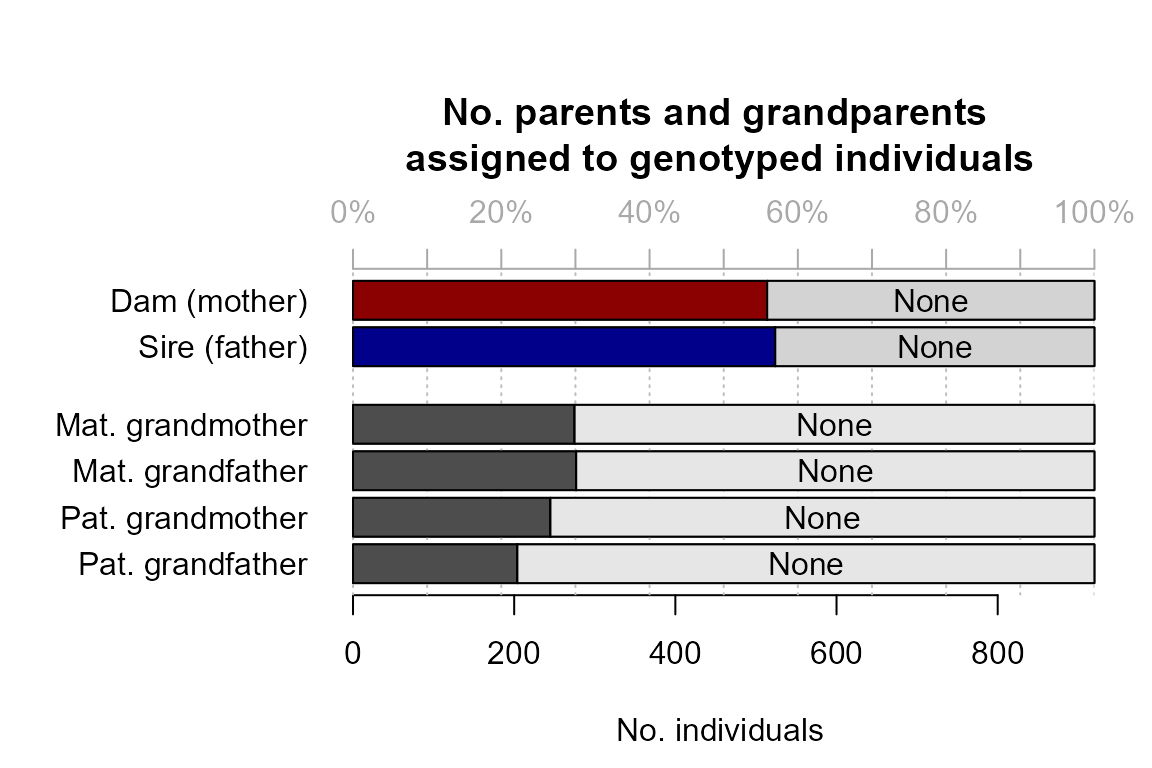
You will see several plots appearing:
- Histograms of the minor allele frequency and missingness, produced
by
SnpStats(), which is called byCheckGeno()to make sure there are no monomorphic SNPs or SNPs with extremely high missingness in the dataset
- Heatmap of the ageprior before parentage assignment, showing that an
age difference of 0 years is disallowed
(,
black) for mothers (M) and fathers (P), but all other
age differences are allowed
(,
pale green) for all relationships. The initial maximum age of parents is
set to the maximum age difference found in the lifehistory data.
- Barplots of assignment rate (produced by
SummarySeq()): nearly 60% of individuals have a genotyped parent assigned, in line with the 40% non-genotyped parents we simulated.
In addition, you will see several messages, including about the initial and post-parentage total LL (log10-likelihood). This is the probability of observing the genotype data, given the (current) pedigree; initially it is assumed that all individuals are unrelated. This number is negative, and gets closer to zero when the pedigree explains the data better.
The result is a list, with the following elements:
names(ParOUT)## [1] "Specs" "ErrM" "args.AP" "Snps-LowCallRate"
## [5] "DupLifeHistID" "NoLH" "AgePriors" "LifeHist"
## [9] "PedigreePar" "TotLikPar" "LifeHistPar"which are explained in detail in the helpfile (?sequoia)
and the main vignette.
you find the assigned parents in list element
PedigreePar:
tail(ParOUT$PedigreePar)## id dam sire LLRdam LLRsire LLRpair OHdam OHsire MEpair
## 915 b05187 a04045 <NA> NA NA NA 0 NA NA
## 916 a05188 a04045 <NA> NA NA NA 0 NA NA
## 917 a05189 <NA> b04177 NA NA NA NA 0 NA
## 918 b05190 <NA> b04177 NA NA NA NA 0 NA
## 919 b05191 <NA> b04177 NA NA NA NA 0 NA
## 920 b05192 <NA> b04177 NA NA NA NA 0 NAwe can compare these to the true parents, in the original pedigree from which we simulated the genotype data:
chk_par <- PedCompare(Ped1 = Ped_HSg5, Ped2 = ParOUT$PedigreePar)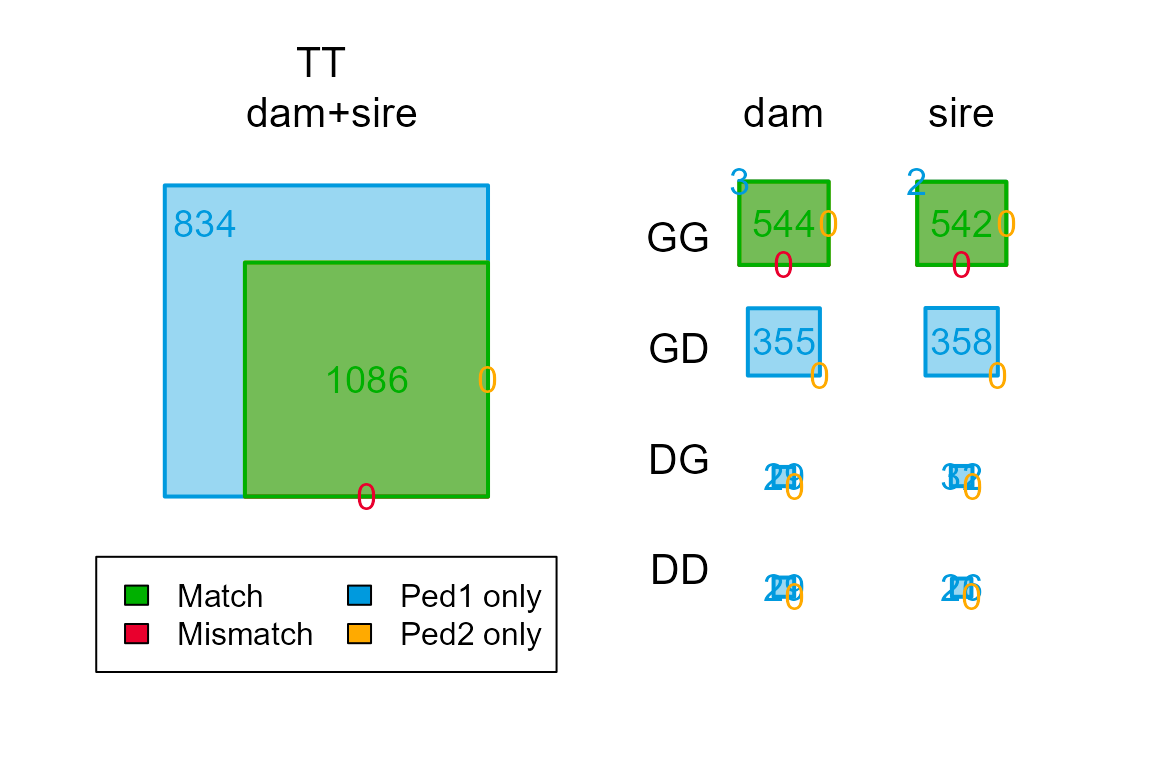
chk_par$Counts["GG",,] ## parent
## class dam sire
## Total 537 544
## Match 513 524
## Mismatch 1 1
## P1only 23 19
## P2only 0 0Here ‘GG’ stands for Genotyped offspring, Genotyped parent.
Pedigree reconstruction
Then, we can run full pedigree reconstruction. By default, this re-runs the parentage assignment.
SeqOUT_HSg5 <- sequoia(GenoM = Geno, LifeHistData = LH_HSg5, Module = "ped")If you don’t want to re-run parentage assignment (e.g. because it took quite a bit of time), or if you have specified several non-default parameter values you want to use again, , you can provide the old output as input.
Re-used will be:
- parameter settings (
$Specs) - genotyping error structure (
$ErrM) - Lifehistory data (
$LifeHist) - Age prior, based on the age distribution of assigned parents
(
$AgePriors)
The last is generated by MakeAgePrior(), which has
detected that all parent-offspring pairs have an age difference of
,
and all siblings an age difference of
,
i.e. that generations do not overlap. This information will be used
during the full pedigree reconstruction.
ParOUT$AgePriors## M P FS MS PS
## 0 0 0 1 1 1
## 1 1 1 0 0 0
## 2 0 0 0 0 0So run sequoia() with the old output as input,
SeqOUT_HSg5 <- sequoia(GenoM = Geno,
SeqList = ParOUT,
Module = "ped")Full pedigree reconstruction will take at least a few minutes to run on this fairly simple dataset with one thousand individuals. It may take a few hours on larger or more complex datasets, and/or if there is much ambiguity about relationships due to a low number of SNPs, genotyping errors, and missing data.
The output from this example pedigree is included with the package:
data(SeqOUT_HSg5)You will get several messages:
- From
CheckGeno()to inform you that the genotype data is OK
- To inform you which parts of
SeqList(the output from the oldsequoia()run) are being re-used
- At the end of each iteration, to update you on the total log10-likelihood (LL), the time it took for that iteration, and the number of dams & sires assigned to real, genotyped (non-dummy) individuals. The total LL and number of assigned parents should plateau (but may ‘wobble’ a bit), and then the algorithm will finish.
Again you will see some plots:
- Histograms of the minor allele frequency and missingness
- Heatmap of an extended version of the ageprior, including all
grandparents and avuncular (aunt/uncle) relationships
(
$AgePriorExtra). These are derived from the ageprior for parents and siblings, which hasn’t changed since just after parentage assignment
- an update of the assignment rates plot, now including dummy parents.
For additional plots and a few tables to inspect the pedigree, you
can use SummarySeq():
summary_seq1 <- SummarySeq(SeqOUT_HSg5, Panels=c("sibships", "D.parents", "LLR"))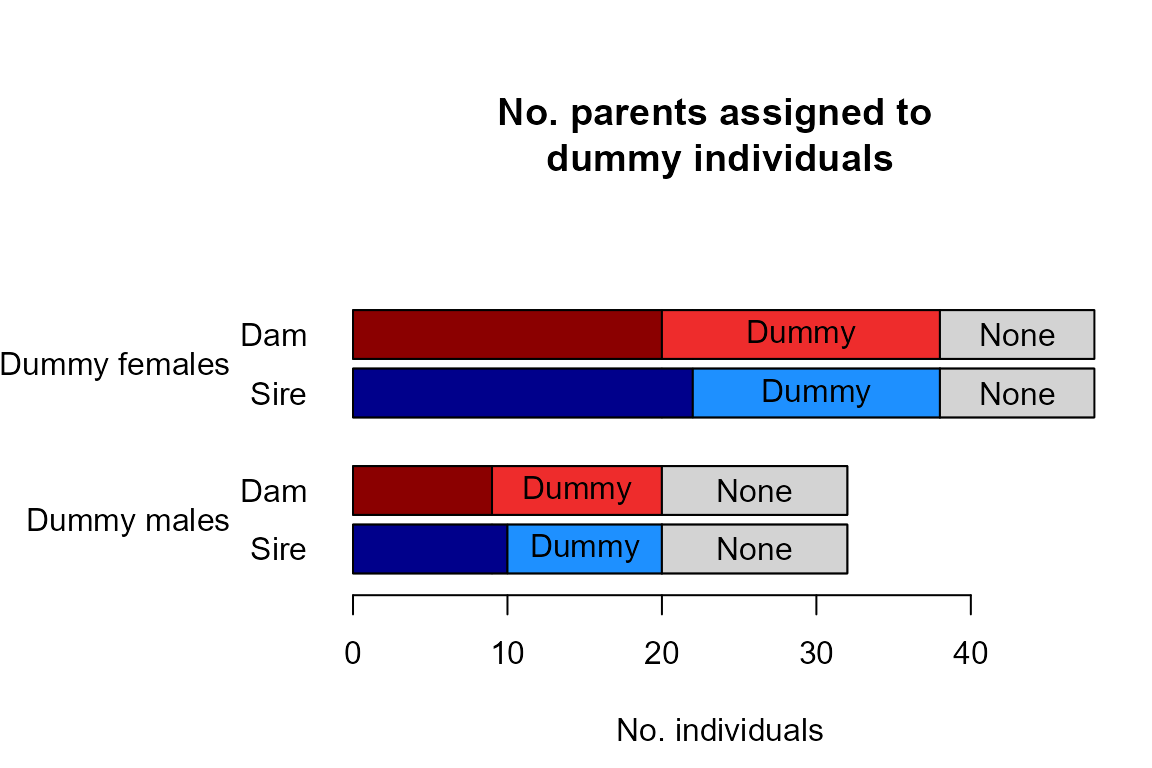
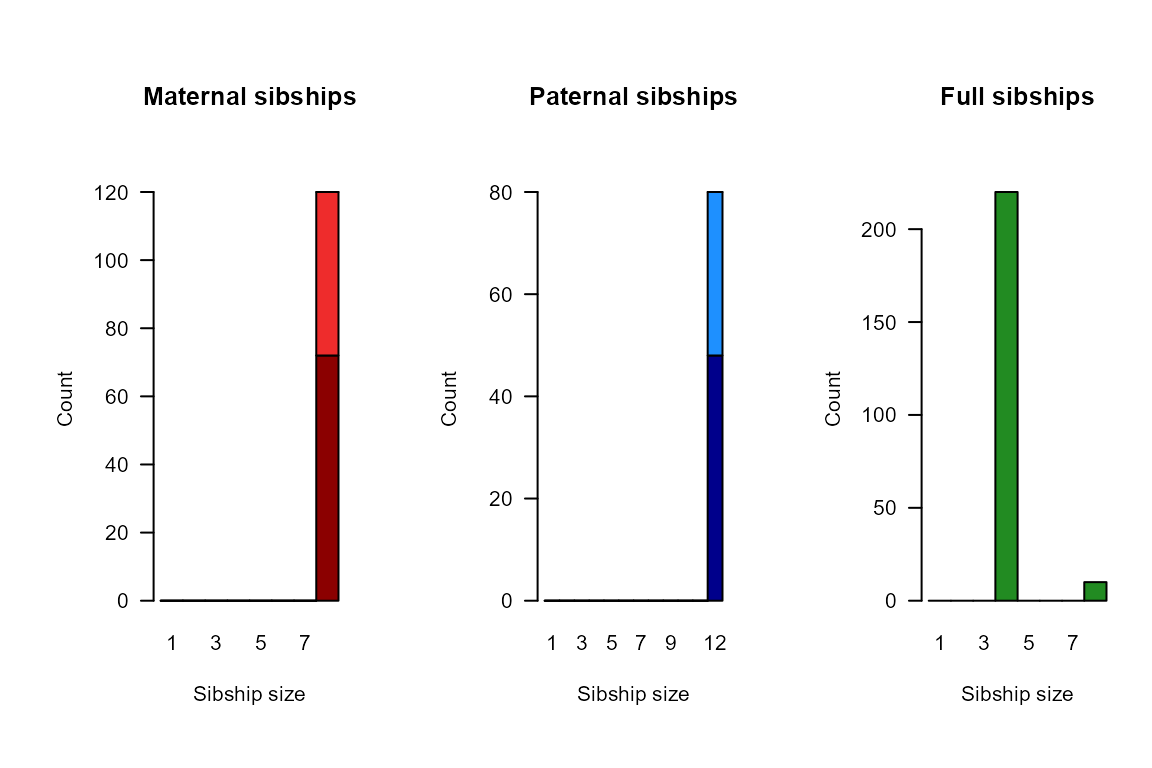
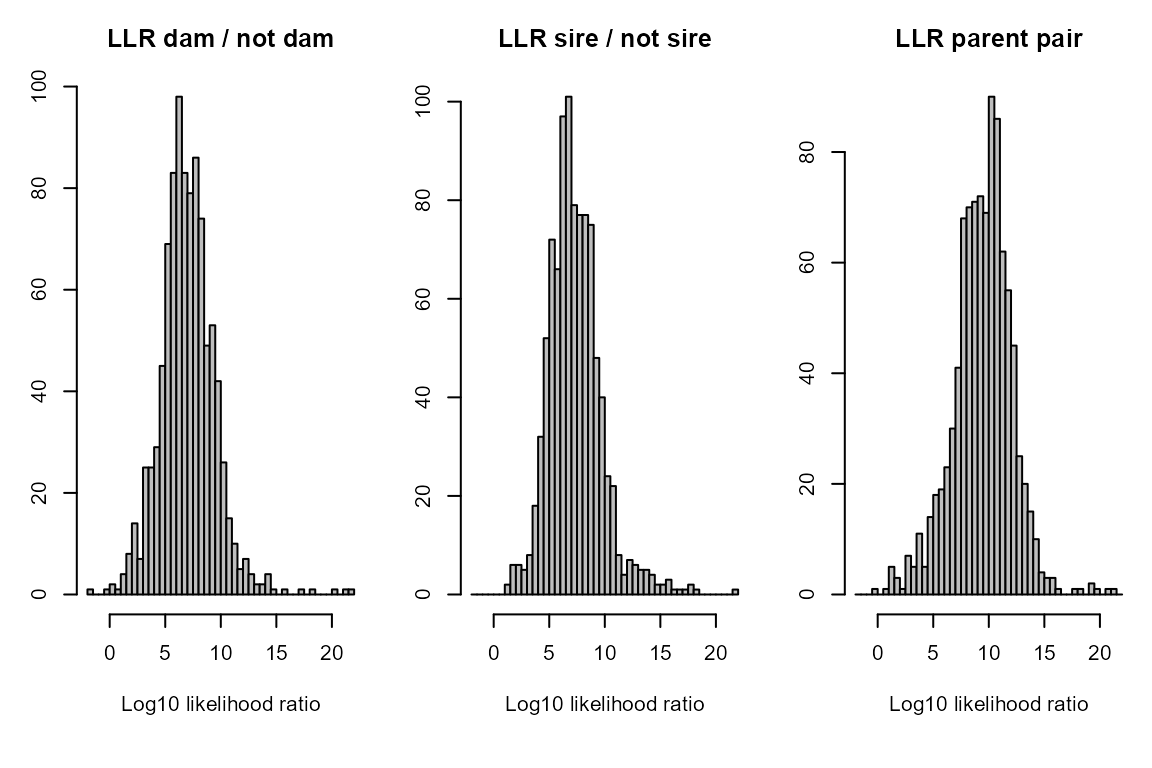
names(summary_seq1)## [1] "PedSummary" "ParentCount" "GPCount" "SibSize"And again we can also compare the results to the true parents:
chk <- PedCompare(Ped1 = Ped_HSg5, Ped2 = SeqOUT_HSg5$Pedigree)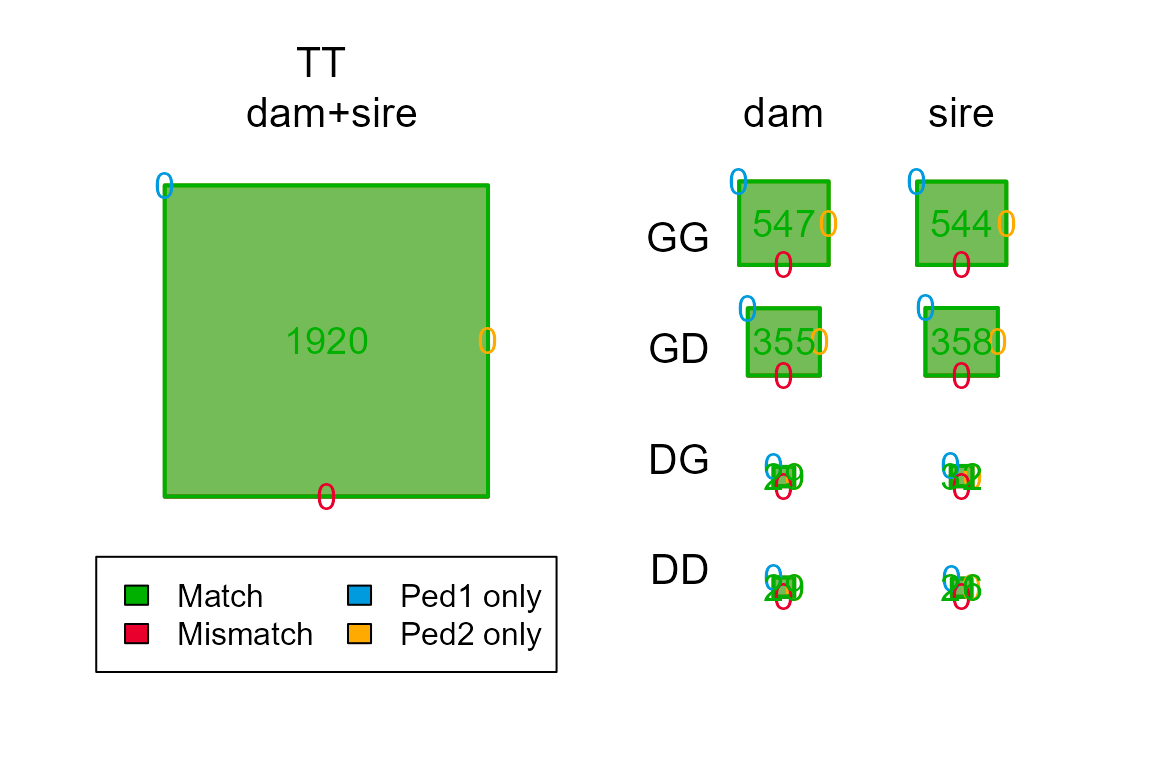
chk$Counts## , , parent = dam
##
## class
## cat Total Match Mismatch P1only P2only
## GG 537 537 0 0 0
## GD 357 357 0 0 0
## GT 894 894 0 0 0
## DG 39 39 0 0 0
## DD 27 27 0 0 0
## DT 66 66 0 0 0
## TT 960 960 0 0 0
##
## , , parent = sire
##
## class
## cat Total Match Mismatch P1only P2only
## GG 543 543 0 0 0
## GD 351 351 0 0 0
## GT 894 894 0 0 0
## DG 33 33 0 0 0
## DD 33 33 0 0 0
## DT 66 66 0 0 0
## TT 960 960 0 0 0See ?PedCompare for a more interesting example with some
mismatches.
If you wish to count e.g. the number of full sibling pairs that are
assigned as full siblings, paternal half siblings, maternal
halfsiblings, or unrelated, or similar comparisons, use
ComparePairs().
Save results
Lastly, you often wish to save the results to file. You can do this
as an Rdata file, which can contain any number of R
objects. You can later retrieve these in R using load, so
that you can later resume where you left of. The disadvantage is that
you cannot open the Rdata files outside of R (as far as I
am aware). Therefore, sequoia also includes a function to
write all output to a set of plain text files in a specified folder.